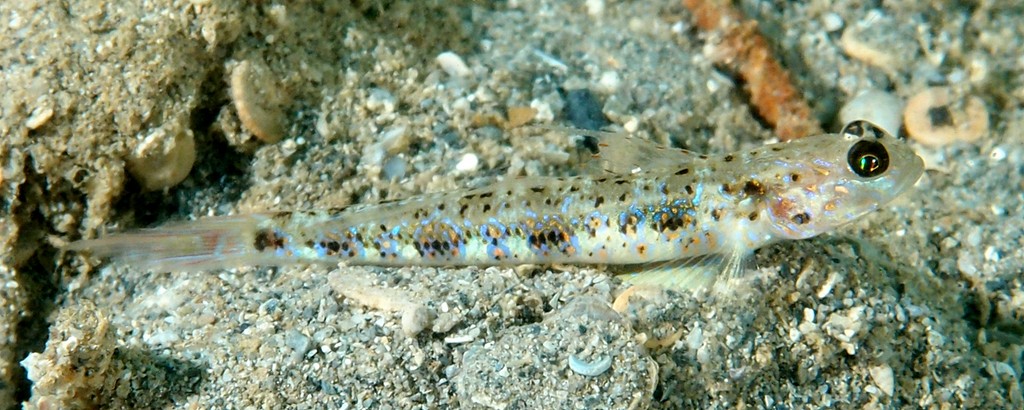VANDERHORSTIA PHAEOSTICTA - (RANDALL, SHAO & CHEN, 2007)
Actinopterygii (Gigaclass) > Actinopteri (Class) > Teleostei (Subclass) > Gobiiformes (Order) > Gobioidei (Suborder) > Gobiidae (Family) > Gobiinae (Subfamily) > Vanderhorstia (Genus)
Gobie à pieds jaunes, Yellowfoot shrimpgoby, Yatsushihaze, ヤツシハゼについて,
Synonymes
Vanderhorstia phaeostictus (Randall, Shao & Chen, 2007)
Ctenogobiops phaeostictus (Randall, Shao & Chen, 2007)
Ctenogobius phaeostictus (Randall, Shao & Chen, 2007)
--------------------------------------------
Synonymes
Vanderhorstia phaeostictus (Randall, Shao & Chen, 2007)
Ctenogobiops phaeostictus (Randall, Shao & Chen, 2007)
Ctenogobius phaeostictus (Randall, Shao & Chen, 2007)
--------------------------------------------
Description
Dorsal spines (total): 6-7; Dorsal soft rays (total): 12-13; Anal spines: 1; Anal soft rays: 13; Pectoral fin: 18-19; Segmented caudal rays: 16, middle: 14 branched, upper and lower procurrent caudal rays: 6; Lateral-line scales: 49; Gill rakers: 2+8; Longitudinal scale series: 46-52; Circumpeduncular scales: 11-12; Cycloid body scales; Head without scales except side of nape; Greatest depth of body: 5.8-6.5 in SL: Ovate caudal fin, longer than head length. Prolonged filament formed by third dorsal spine, sometimes more than 50% SL in adult male; United pelvic fins, presence of well developed frenum. Max length: 5.0 cm TL. Depth range: 8 - 20 m.
Etymology
Vanderhorstia: in honnor of Professor C.J. van der Horst (1889-1951) of the Witwatersrand University (South Africa) for a donnation of fishes collection.
phaeostictus: from Greek, phaiós = gray + from Greek, stictus = spotted, dotted. Refers to the profusion of small dark spots on the body.
Original description: Ctenogobiops phaeostictus Randall, Shao & Chen, 2007 - Type locality: lagoon side of Pig Island, Madang Province, Papua New Guinea, depth 10 meters, quinaldine (Quinaldine sulfate is an anaesthetic used in fish transportation. In some Caribbean islands it is used to facilitate the collection of tropical fish from reefs), J.E. Randall, 2 Nov. 1987.
Distribution
Western Pacific: Indonesia east to Philippines and Papua New Guinea, north to Ryukyu Islands, south to New Caledonia.
Biology
Inhabits shallow sandy and rubble areas, sometimes among seagrass, and in silty lagoons amongst rubble. Shares burrows with alpheid shrimps. Feeds on benthic invertebrates.
Similar species
Vanderhorstia dawnarnallae (Allen, Erdmann & Mongdong, 2019) - Reported from western Pacific: West Papua Province, Indonesia.
Dorsal spines (total): 6-7; Dorsal soft rays (total): 12-13; Anal spines: 1; Anal soft rays: 13; Pectoral fin: 18-19; Segmented caudal rays: 16, middle: 14 branched, upper and lower procurrent caudal rays: 6; Lateral-line scales: 49; Gill rakers: 2+8; Longitudinal scale series: 46-52; Circumpeduncular scales: 11-12; Cycloid body scales; Head without scales except side of nape; Greatest depth of body: 5.8-6.5 in SL: Ovate caudal fin, longer than head length. Prolonged filament formed by third dorsal spine, sometimes more than 50% SL in adult male; United pelvic fins, presence of well developed frenum. Max length: 5.0 cm TL. Depth range: 8 - 20 m.
Color
Variable color, often pale grey to yellowish with row of large, diffuse blackish blotches on lower half of side; Blue-edged yellow spots prominent on lower side between or on margin of blackish blotches; 6-7 diffuse, blackish saddles on back; Head with yellow oblique bands; Yellow pelvic fins with blue spots in adult male; Dorsal fin rays with short brown lines.
Etymology
Vanderhorstia: in honnor of Professor C.J. van der Horst (1889-1951) of the Witwatersrand University (South Africa) for a donnation of fishes collection.
phaeostictus: from Greek, phaiós = gray + from Greek, stictus = spotted, dotted. Refers to the profusion of small dark spots on the body.
Original description: Ctenogobiops phaeostictus Randall, Shao & Chen, 2007 - Type locality: lagoon side of Pig Island, Madang Province, Papua New Guinea, depth 10 meters, quinaldine (Quinaldine sulfate is an anaesthetic used in fish transportation. In some Caribbean islands it is used to facilitate the collection of tropical fish from reefs), J.E. Randall, 2 Nov. 1987.
Distribution
Western Pacific: Indonesia east to Philippines and Papua New Guinea, north to Ryukyu Islands, south to New Caledonia.
Biology
Inhabits shallow sandy and rubble areas, sometimes among seagrass, and in silty lagoons amongst rubble. Shares burrows with alpheid shrimps. Feeds on benthic invertebrates.
Similar species
Vanderhorstia dawnarnallae (Allen, Erdmann & Mongdong, 2019) - Reported from western Pacific: West Papua Province, Indonesia.
Vanderhorstia ornatissima (Smith, 1959) - Reported from New Caledonia - Link to the species (here).
Vanderhorstia wayag (Allen & Erdmann, 2012) - Reported from Western Pacific: Raja Ampat Islands, West Papua, Indonesia.
